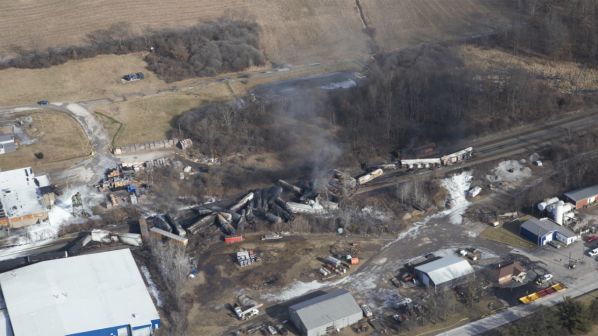NORTH American Class 1 Norfolk Southern (NS) has announced a six-point plan to immediately enhance the safety of its operations, following the derailment of a freight train carrying hazardous materials in East Palestine, Ohio, on February 3.
The initiatives, announced on March 6, are based on the preliminary findings of the National Transportation Safety Board’s (NTSB) investigation of the derailment and were released a day before NTSB announced it was launching a “special investigation of Norfolk Southern Railway’s organisation and safety culture.”
NTSB’s preliminary report traced the derailment and the initial fire to an overheated axle on wagon 23, which was carrying plastic pellets. Subsequent NTSB testing indicated that the aluminium covers over the pressure relief valves on three of the five tank cars carrying vinyl chloride melted during the fire. NTSB found that the NS crew operated the train according to the company’s rules and within the maximum speed on the section of track in question. In addition, NTSB says that the lineside hot bearing detectors at the scene of the accident were operating as designed.
NS will immediately begin six initiatives.
Firstly, it will enhance the hot bearing detector network. NS is evaluating the distance between hot bearing detectors, which currently averages 22.36km on its core network and will examine every location on its core network where the distance is more than 24km. NS anticipates adding approximately 200 hot bearing detectors to its network, with the first installed on the western approach to East Palestine.
It will also pilot next-generation hot bearing detectors. NS is working with manufacturers to accelerate the testing and deployment of “multi-scan” detectors that can scan a greater cross-section of a wagon’s bearings and wheels.
Thirdly, it will work with industry on a comprehensive review of standards and practices for the use of hot bearing detectors. In addition to revaluating the temperature threshold at which an alarm is triggered, NS said it plans to work with peers to analyse data for patterns that could provide earlier warnings of potential safety issues.
The railway will deploy more acoustic bearing detectors, which play a different role in its safety inspection programme. “These detectors analyse the acoustic signature of vibration inside the axle and can identify potential problems that a visual inspection could not,” NS says. The railway will add 13 new detectors to the five already in service on high-traffic routes within its core network.
NS will accelerate its Digital Train Inspection programme and is partnering with Georgia Tech Research Institute to develop next-generation safety inspection technology. This uses machine vision and algorithms powered by artificial intelligence (AI) to identify defects and the required repairs much more effectively than traditional human inspection.
Finally, NS says it will support a strong safety culture and has agreed to join the Federal Railroad Administration’s (FRA) Confidential Close Call Reporting System (C3RS).
NTSB investigation
NTSB says its special investigation follows five significant accidents on the NS network:
- on December 8 2021, an employee of National Salvage and Service assigned to work with an NS team replacing track was killed when the operator of a spike machine reversed direction and struck the employee in Reed, Pennsylvania
- on December 13, 2022, an NS trainee conductor was killed, and another conductor injured, when the lead locomotive of an NS freight train struck a steel angle iron protruding from a gondola car on another NS freight train that was stopped on an adjacent track in Bessemer, Alabama
- the derailment on February 3 at East Palestine, Ohio
- on March 4, a 4.1km-long NS freight train derailed near Springfield, Ohio, and
- on March 7, an NS employee was killed during a train movement in Cleveland, Ohio.
“As part of the special investigation, the NTSB will also review the October 8 2022 NS derailment in Sandusky, Ohio,” the agency said. “The NTSB is concerned that several organisational factors may be involved in the accidents, including safety culture. The NTSB will conduct an in-depth investigation into the safety practices and culture of the company. At the same time, the company should not wait to improve safety and the NTSB urges it to do so immediately.”
“Moving forward, we are going to rebuild our safety culture from the ground up,” said NS president and CEO Mr Alan Shaw. “We are going to invest more in safety. This is not who we are, it is not acceptable, and it will not continue.”

